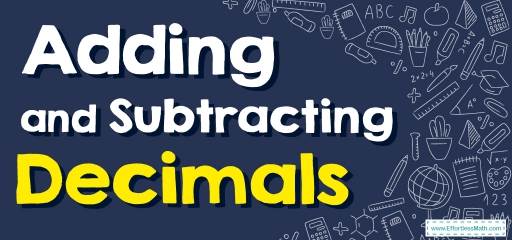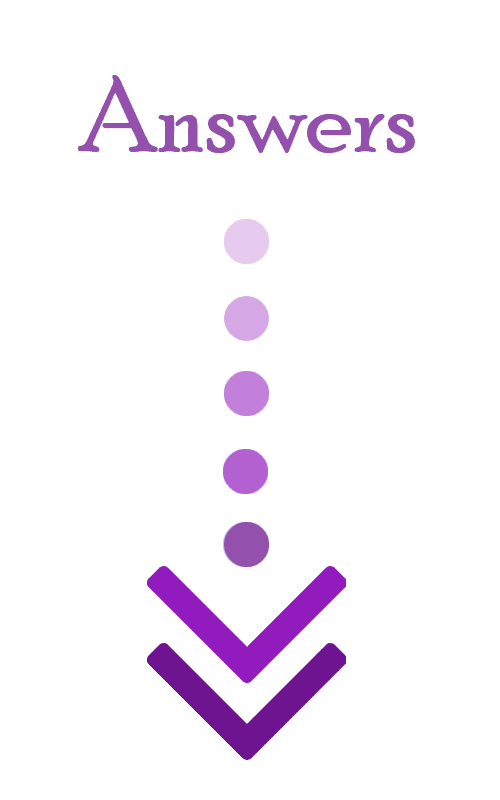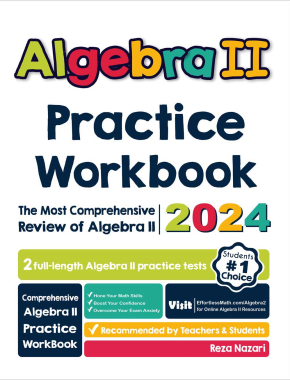How to Add and Subtract Decimals? (+FREE Worksheet!)
Decimals are a way of displaying very small numbers without using a fraction. Decimal numbers are numbers that consist of two parts, integer, and decimal. Here, you can learn how to add and subtract decimals in a few simple steps.

Decimals are a way of displaying very small numbers without using a fraction. Decimal numbers are numbers that consist of two parts, integer, and decimal. Fractions whose denominator is \(10\) or \(100\) or \(1000\) or … are called decimal fractions.
Note: In decimal numbers, the first digit after the decimal point is called the tenth, the second digit is the hundredth, the third digit is the thousandth, and so on.
The Absolute Best Books to Ace Pre-Algebra to Algebra II
Related Topics
Step-by-step guide to adding and subtracting decimals
Adding and subtracting decimal numbers are almost as simple as adding and subtracting integers.
Follow the steps below to add or subtract decimal numbers:
- Step 1: Put the bigger number above. Using the zero in front of the decimal point after the last number, equal the number of digits in front of the decimal point in the numbers.
- Step 2: We write the part of integers below each other: unit below unit, tens below tens and so on.
- Step 3: We write the decimal point below the decimal point.
- Step 4: We write the decimal parts below each other, that is, the tenth below the tenth, the hundredth below the hundredth, and so on.
- Step 5: Like adding or subtracting integers, we do the addition or subtraction operation.
Adding and Subtracting Decimals – Example 1:
Add. \(1.5 \ + \ 2.14=\)
Solution:
First line up the numbers: \(\begin{array}{r} &1.5\\ +\!\!\!\!\!&2.14\\ \hline \end{array}→ \) Add zeros to have same number of digits for both numbers. \(\begin{array}{r} &1.50\\ +\!\!\!\!\!\!&2.14\\ \hline \end{array} \), Start with the hundredths place. \(0 \ + \ 4=4\), \(\begin{array}{r} &1.50\\ +\!\!\!\!\!\!&2.14 \\ \hline \end{array} \\ \ \ \ \ \ \ \ \ \ \ \ 4\) , Continue with tenths place. \(5 \ + \ 1=6\), \(\begin{array}{r} &1.50\\ +\!\!\!\!\!\!&2.14 \\ \hline \end{array} \\ \ \ \ \ \ \ \ \ .64\). Add the ones place. \(1 \ + \ 2=3\), \(\begin{array}{r} &1.50\\ +\!\!\!\!\!\!&2.14 \\ \hline \end{array} \\ \ \ \ \ \ \ 3.64\)
The Best Book to Help You Ace Pre-Algebra
Adding and Subtracting Decimals – Example 2:
Subtract decimals. \(2.56 \ – \ 1.15= \begin{array}{r} &2.56\\ – \!\!\!\!\!\!&1.15\\ \hline \end{array} \)
Solution:
Start with the hundredths place. \(6 \ – \ 5=1\), \( \begin{array}{r} &2.56\\ – \!\!\!\!\!\!&1.15\\ \hline \end{array} \\ \ \ \ \ \ \ \ \ \ \ \ 1 \), continue with tenths place. \(5 \ – \ 1=4\), \( \begin{array}{r} &2.56\\ – \!\!\!\!\!\!&1.15\\ \hline \end{array} \\ \ \ \ \ \ \ \ \ .41 \), put the decimal point and subtract the ones place. \(2 \ – \ 1 =1\), \( \begin{array}{r} &2.56\\ – \!\!\!\!\!\!&1.15\\ \hline \end{array} \\ \ \ \ \ \ \ 1.41 \)
Adding and Subtracting Decimals – Example 3:
Add. \(2.5 \ + \ 1.24=\)
Solution:
First line up the numbers: \(\begin{array}{r} &2.5\\ +\!\!\!\!\!\!&1.24\\ \hline \end{array}→ \) Add zeros to have same number of digits for both numbers. \(\begin{array}{r} &2.50\\ +\!\!\!\!\!\!&1.24\\ \hline \end{array} \), Start with the hundredths place. \(0 \ + \ 4=4\), \(\begin{array}{r} &2.50\\ +\!\!\!\!\!\!&1.24 \\ \hline \end{array} \\ \ \ \ \ \ \ \ \ \ \ \ 4\), Continue with tenths place. \(5 \ + \ 2=7\), \(\begin{array}{r} &2.50\\ +\!\!\!\!\!\!&1.24 \\ \hline \end{array} \\ \ \ \ \ \ \ \ \ .74\) . Put the decimal point and add the ones in place. \(2 \ + \ 1=3\), \(\begin{array}{r} &2.50\\ +\!\!\!\!\!\!&1.24 \\ \hline \end{array} \\ \ \ \ \ \ \ 3.74\)
Adding and Subtracting Decimals – Example 4:
Subtract decimals. \(4.67 \ – \ 2.15= \begin{array}{r} &4.67\\ – \!\!\!\!\!\!&2.15\\ \hline \end{array} \)
Solution:
Start with the hundredths place. \(7 \ – \ 5=2\), \( \begin{array}{r} &4.67\\ – \!\!\!\!\!\!&2.15\\ \hline \end{array} \\ \ \ \ \ \ \ \ \ \ \ \ 2 \), continue with tenths place. \(6 \ – \ 1=5\), \( \begin{array}{r} &4.67\\ – \!\!\!\!\!\!&2.15\\ \hline \end{array} \\ \ \ \ \ \ \ \ \ .52 \), put the decimal point and subtract the ones place. \(4 \ – \ 2 =2\), \( \begin{array}{r} &4.67\\ – \!\!\!\!\!\!&2.15\\ \hline \end{array} \\ \ \ \ \ \ \ 2.52 \)
Exercises for Adding and Subtracting Decimals
Add and subtract decimals.
1. \(\color{blue}{ \begin{array}{r} &15.14\\ -\!\!\!\!\!\!&12.18\\ \hline \end{array} }\)
2. \(\color{blue}{ \begin{array}{r} &65.72\\ +\!\!\!\!\!\!&43.67\\ \hline \end{array} }\)
3. \(\color{blue}{ \begin{array}{r} &82.56\\ +\!\!\!\!\!\!&12.28\\ \hline \end{array} }\)
4.\(\color{blue}{ \begin{array}{r} &34.18\\ -\!\!\!\!\!\!&23.45\\ \hline \end{array} }\)
5. \(\color{blue}{ \begin{array}{r} &90.37\\ +\!\!\!\!\!\!&56.97\\ \hline \end{array} }\)
6. \(\color{blue}{ \begin{array}{r} &45.78\\ -\!\!\!\!\!\!&23.39\\ \hline \end{array} }\)
Download the Adding and Subtracting Decimals Worksheet

- \(\color{blue}{2.96}\)
- \(\color{blue}{109.39}\)
- \(\color{blue}{94.84}\)
- \(\color{blue}{10.73}\)
- \(\color{blue}{147.34}\)
- \(\color{blue}{22.39}\)
The Greatest Books for Students to Ace the Algebra
Related to This Article
More math articles
- How to Add and Subtract Radical Expressions? (+FREE Worksheet!)
- How to Simplify Polynomial Expressions? (+FREE Worksheet!)
- Studying Math Can Foster Analytical Skills
- How to Prepare for the SAT Math Test?
- 8th Grade MAP Math Practice Test Questions
- How to Find Missing Sides and Angles of a Right Triangle? (+FREE Worksheet!)
- Word Problems Involving Money
- How to Solve Natural Logarithms Problems? (+FREE Worksheet!)
- FTCE General Knowledge Test Review
- Decimal Dynamics: How to Master the Art of Adding and Subtracting Decimals















What people say about "How to Add and Subtract Decimals? (+FREE Worksheet!) - Effortless Math: We Help Students Learn to LOVE Mathematics"?
No one replied yet.